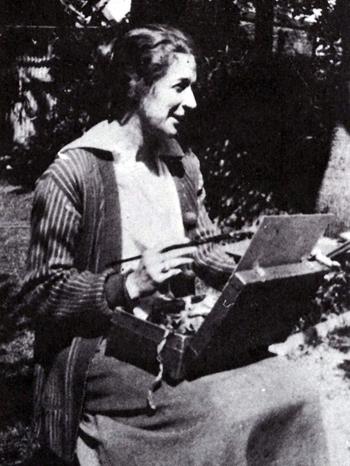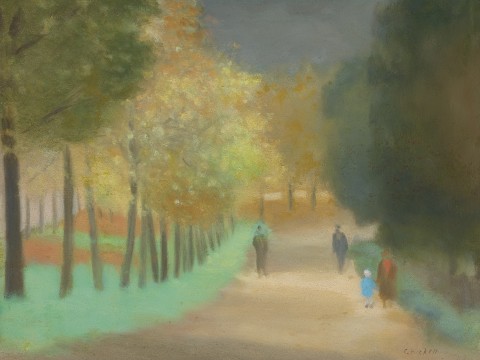THE TAN, SOUTH YARRA, c.1925
CLARICE BECKETT
oil on board
34.5 x 45.5 cm
signed lower right: C. Beckett
Rosalind Hollinrake Galleries, Melbourne
Private collection, Melbourne, acquired from the above c.1979
Thence by descent
Christie’s, Sydney, 17 August 1999, lot 4
Private collection, Sydney
Clarice Beckett: The Present Moment, Art Gallery of South Australia, Adelaide, 27 February – 23 May 2021
Lock, T., Clarice Beckett: The Present Moment, Art Gallery of South Australia, Adelaide, 2021, pp. 74, 200 (illus.)
Yellow Leaves, Alexandra Avenue, 1925, 29.0 x 39.5 cm, private collection, illus. in Hollinrake, R., Clarice Beckett: Politically Incorrect, The Ian Potter Museum of Art, The University of Melbourne, Melbourne, 1999, pl. 14, cat. 10, pp. 44, 75
We are grateful to Rosalind Hollinrake for her assistance with this catalogue entry.
210184.jpg

The Tan is a path that runs the circumference of the Royal Botanic Gardens in Melbourne. It was marked out in the early 1900s as a tanbark horse-riding track – hence the name – but by 1960, the rising costs of stabling and feeding horses near to the city meant that trainers went elsewhere.1 Over the next decades, it was transformed into its contemporary version resounding to the pounding feet of joggers marking time on digital clocks. In The Tan, South Yarra, (late 1920s), Clarice Beckett stood at a position on Linlithgow Avenue, adjacent to what is now the Myer Music Bowl, looking down the gentle incline to the curve that takes the track through to Alexandra Avenue. Painted on a commercial card support known as ’Beaver board’, the original study would have been executed on the spot, later finished into this consummate whole at the kitchen table of the Beckett family home in Beaumaris.
Beckett showed early talent and trained at the National Gallery Art School for three years from 1914. Following this, she studied for nine months under the controversial artist-theorist Max Meldrum who had developed his own ‘science of optics’ based on tonal values and proportion, which ultimately ‘facilitated an aesthetic shift in Australian art, away from a celebratory impressionist ‘glare’ to a vaporous ‘haze.’’2 Over time, however, Beckett’s subsequent life story has become shrouded in almost mythic proportions of tragedy leading to a range of misinterpretations. One error is that due to her duties as carer to elderly parents, she was only able to paint in the early morning or evening when such work was completed; but as Tracy Lock points out in her catalogue for the recent exhibition Clarice Beckett: the present moment (Art Gallery of South Australia), these restrictions only became intrusive during the last few years of her life. Prior to this, she had the relative freedom to roam in search of subjects, and the city was a favourite location.3
Beckett also had a deep understanding of Theosophy and in her paintings, the viewer is subtly aware of the artist herself, standing just out of frame, absorbing the scene in front of her and seeking its underlying spiritual pulse. The blossoming tree to the left in The Tan, South Yarra, and the long coats worn in spite of sunlit patches, indicate that she has captured an early spring day in this warmly inviting view. The painting also reveals Beckett’s skill in composition with its parallel rows of trees creating a vertical emphasis that establishes ‘a frame within a frame’. She utilised the same device in a number of works from the late 1920s, including Beach Road after the rain, c.1927 (National Gallery of Victoria), and Motorbike and sidecar, c.1928 (Warrnambool Art Gallery). After years of neglect, Beckett’s reputation has slowly been re-established in recent decades with the realisation now that she is one of the most significant Australian modernists of her day.
1. See ‘News of the Day’, The Age, Melbourne, 1 February 1960. An alternate source for the name may be an abbreviation of the BoTANical Gardens.
2. Lock, T., Clarice Beckett: The present moment, Art Gallery of South Australia, Adelaide, 2021, p. 158
3. Ibid., p. 138
ANDREW GAYNOR
